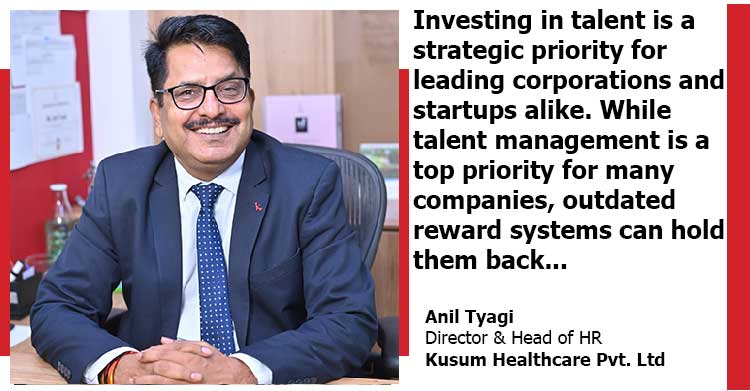Why Employee Rewarding Matters: Investing in People, Investing in Success | Anil Tyagi | Director & Head of HR | Kusum Healthcare Pvt. Ltd

Investing in talent is a strategic priority for leading corporations and startups alike. While talent management is a top priority for many companies, outdated reward systems can hold them back. As HR professionals, it’s our responsibility to guide young business leaders in revamping these programs.
Traditional rewards often miss the mark. We need to move beyond generic bonuses and one-size-fits-all approaches. Tailored to today’s workforce, recognizing not just results but also contributions to company culture and individual growth should constitute an effective reward system.
As we deep dive to explore key steps for building a rewarding system, here are the two major points:
1. Move beyond financial incentives and make it transparent, or MBFIMT
2. Align rewards with values and personalize experiences, or AWVPE
MBFIMT: Rewarding More Than Just Tasks
While compensation certainly plays a role, it shouldn’t be the sole focus when considering employee rewards. Employees are increasingly seeking work that aligns with their values. Companies that demonstrate a commitment to social responsibility, environmental sustainability, or diversity and inclusion are more likely to attract and retain top talent. When considering a job change, skilled workers are looking beyond just the paycheck. They want to be part of an organization they can be proud of. A well-rounded reward system can incorporate these aspects:
Company Culture: Foster a culture of transparency, open communication, and appreciation. Employees who feel valued and respected are more likely to be engaged and productive.
Social Impact: Offer opportunities for employees to contribute to causes they care about through volunteer programs or charitable partnerships.
Work-Life Balance: Promote healthy boundaries between work and personal life by offering flexible work arrangements or wellness programs.
MBFIMT: HR: Champions of Wellbeing and Productivity
Human Resources departments play a crucial role in bridging the gap between employee wellbeing and economic priorities. By implementing comprehensive reward systems that go beyond just compensation, HR can demonstrate that a happy and healthy workforce is also a productive one. This means offering programs that promote work-life balance, mental health support, and opportunities for professional development. These initiatives not only improve
employee morale but also reduce absenteeism and burnout, ultimately benefiting the company’s bottom line.
Effective HR strategies can be:
Design Well-Being Programs: Offer programs that address both physical and mental health, such as mindfulness training, or access to counseling services.
Implement Flexible Schedules: Allowing employees to manage their work hours can significantly reduce stress and improve overall satisfaction.
Create a Supportive Environment: Foster a work environment where employees feel comfortable asking for help and expressing concerns.
MBFIMT: The Peril of Overcommitment and Low Rewards
When employees are expected to go above and beyond without appropriate rewards, it can lead to a threatening cycle of overcommitment and emotional exhaustion. One-time bonuses and “perks” like free lunches or company outings might feel good in the moment, but they don’t offer the sustained motivation that comes from regular pay raises and recognition programs.
Employees who feel undervalued eventually become disengaged, leading to decreased productivity and higher turnover.
Here’s why this approach can be detrimental:
Unsustainable Motivation: One-time bonuses create a temporary high, but the motivation wears off quickly if not supported by consistent rewards.
Perks Lose Their Shine: Free lunches and game rooms can be attractive initially, but they lose their appeal over time. Employees crave more meaningful forms of recognition.
Emotional Exhaustion: When employees are overworked and under-rewarded, they become susceptible to emotional exhaustion. This can lead to a decline in performance and increased absenteeism.
AWVPE: The Fallacy of “Same Job, Same Pay”
The “same job, same pay” bill, while seemingly fair on the surface, can have unintended consequences. While new hires deserve competitive salaries, experienced workers bring a wealth of knowledge, skills, and institutional memory to the table. They are often more efficient, require less supervision, and can mentor junior colleagues. Same job same pay can lead to several issues:
Demotivation: Experienced workers may feel undervalued and demotivated, leading to decreased productivity and a decline in overall morale.
Loss of Expertise: Disgruntled employees with valuable experience may seek opportunities elsewhere, leaving the company with a knowledge gap that can be costly to fill.
Reduced Innovation: Experienced workers often drive innovation through their understanding of the industry and past successes. Losing their enthusiasm can stifle creativity and hinder progress.
AWVPE: Recognizing the Value of “Grueling” Jobs
Certain jobs by their very nature are more demanding, physically, or mentally. Nurses, firefighters, construction workers, and sanitation workers all perform essential tasks that often go unappreciated. Companies need to acknowledge the value of these roles by structuring their rewards to reflect the level of effort and commitment required. This could include higher base salaries, additional paid time off, or signing bonuses to attract qualified candidates.
Benefits of proper reward system:
Reduced Turnover: High-stress jobs often experience significant turnover. Competitive compensation packages, along with benefits like additional paid time off or healthcare stipends, can incentivize workers to stay.
Improved Performance: When employees feel their efforts are appreciated, they’re more likely to go the extra mile, leading to improved quality of work and increased efficiency.
Attracting Top Talent: Rewarding demanding jobs appropriately helps attract high-performing individuals with the necessary skills and resilience.
AWVPE: The Role of HR in Reward Strategy
The responsibility for designing and implementing an effective employee reward system falls squarely on the shoulders of the HR department. This involves more than simply cutting checks or distributing company swag. HR professionals need to understand employee needs, company goals, and industry trends to create a system that is both fair and motivating. This might include conducting employee surveys, benchmarking compensation practices, and developing a framework for recognition programs.
HR plays a critical role in this process:
Performance Reviews: Implement a system that objectively measures performance and identifies high-performing employees.
Peer Recognition: Encourage peer-to-peer recognition programs for team contributions and positive company culture.
As I conclude, I must remind you that a well-designed employee reward system is not an expense, it’s an investment. By recognizing employee contributions, advancing a positive work environment, and offering competitive compensation packages, companies can build a loyal and engaged workforce. This translates to increased productivity, innovation, and customer satisfaction. In today’s competitive landscape, companies that prioritize employee rewards are not just doing the right thing, they’re setting themselves up for competitive business advantage and long-term success.


